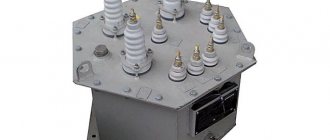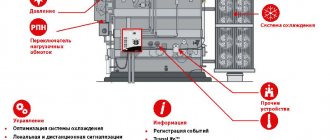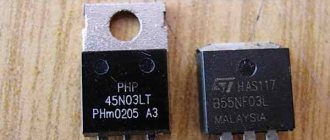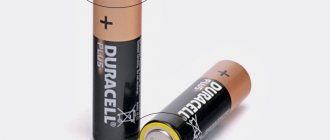Design and features
The main design difference between the armored transformer (BT) and other single-phase transformers can be easily seen in Figure 1, b.
Rice. 1 – Schemes of single-phase transformers
Figures 1a and 1c show rod (ST) and toroidal (TT), respectively. The CT design scheme is opposite to the BT scheme in terms of the location of the main elements relative to each other, and in the first it is the other way around - the core is covered by windings. The BT, in comparison with the ST, has fewer outputs for the same number of windings, since the primary winding of the ST must be distributed in two equal parts between the magnetic conductor rods.
In this regard, in certain cases with CT there are difficulties in placing the leads, however, if the core is detachable tape, then the CT will even have an advantage, manifested in the ability to provide a small gap in the core and tighten its two halves.
Characteristic
The mere presence of such parts leads to an increase in weight and volume. The armored design to some extent reduces the dimensions of the BT, while the side yokes serve as protection against mechanical stress for the windings. This is extremely important, given the small dimensions, the absence of a casing and the location together with other equipment on the circuit, and not separately. The TT has the smallest number of elements, which means its dimensions are least susceptible to growth, but at the same time it is also structurally the least technologically advanced.
Technological disadvantages are expressed, firstly, in the need for sequential production of the core and coils (lengthening the production cycle), and secondly, in low productivity during winding of the latter.
In addition to this, the toroidal winding machine is significantly more complex and expensive compared to conventional line winding machines, and cannot be used for winding wire whose diameter exceeds 2 mm. This narrows the scope of CT application at high powers, while at very low powers the core window may not be enough to pass the shuttle. It is especially difficult to wind CTs at a given frequency of 50 Hz, when a lot of turns are needed.
Against the background of the above, another significant advantage of BT appears - it is the most technologically advanced solution in conditions of low power, with stamped cores. Moreover, its superiority in relation to CT is also weighty - only one coil is required, not two. In general, the difference between two coils and one always comes to the fore when small-sized transformers are required.
Types of magnetic cores
Based on the design of the magnetic circuit, transformers are divided into rod and armored.
| Figure 1. Design of single-phase rod (a) and armored (b) transformers |
The magnetic core of a single-phase rod transformer (Figure 1, a) has two rods C, on which the windings are placed, and two yokes R, which serve to create a closed magnetic circuit. Each of the two windings (1 and 2) consists of two parts located on two rods, and these parts are connected either in series or in parallel. With this arrangement, the primary and secondary windings are close to each other, which leads to an increase in the electromagnetic coupling coefficient [see equality (1) in the article “Principle of operation and types of transformers”].
A single-phase transformer of an armored design (Figure 1, b) has one rod with windings and a developed yoke, which partially covers the windings like “armor”.
To convert, or transform, three-phase current, you can use three single-phase transformers (Figure 2), the windings of which are connected in a star or delta circuit and connected to a three-phase network. Such a device is called a three-phase transformer group or group transformer . More often, however, three-phase transformers with a common magnetic core for all phases are used, since such transformers are more compact and cheaper.
| Figure 2. Three-phase transformer group | Figure 3. The idea of forming a three-phase three-leg transformer |
The idea of forming a three-phase rod-type transformer is shown in Figure 3. If the condition is met for three-phase sinusoidal currents
ia + ib + ic = 0,
then for the sinusoidal flows of three transformers (Figure 3, a) the condition is also met
Фa + Фb + Фc = 0
Therefore, if you combine three rods 1, 2 and 3 (Figure 3, a) into a common rod, then the flow in this rod will be zero and this rod can be removed. Then we get a three-phase three-rod transformer, shown in Figure 3, b. The design of this transformer can be simplified by placing all three rods in the same plane (Figure 3, c). This last design was proposed by M. O. Dolivo-Dobrovolsky in 1889 and became widespread. Such a magnetic circuit is not completely symmetrical, since the length of the magnetic lines of the middle phase is somewhat shorter than for the outer ones, but the influence of this asymmetry is very insignificant.
A three-phase armor transformer (Figure 4) can be considered as three single-phase armor transformers placed next to or on top of each other. In this case, the middle phase has a reverse inclusion relative to the outer ones, so that in the contacting parts of the magnetic system the phase fluxes are added and not subtracted. Because
, then with such inclusion of the middle phase, the flux in the contacting parts of the magnetic system decreases by √3 times, and the cross-section of these parts of the magnetic circuit can be reduced by the same amount. In this case, the flows in all parts of the yoke are equal to half the flow of the rods.
| Figure 4. Design of a three-phase armored transformer |
In armored transformers, the coefficient of electromagnetic coupling between the windings is somewhat higher than in rod transformers, and therefore armored transformers are somewhat more advanced in electromagnetic terms. However, this advantage is not significant. Since armored transformers are more complex in design, armored power transformers are not built in Russia.
As the power of transformers increases, their size and difficulty of transportation by rail increase. Therefore, in transformers with a power Sn > 80 - 100 MV×A per phase and a voltage of 220 - 500 kV, an armored rod or multi-rod design is used. Such designs are obtained if, for transformers of the type shown in Figures 1, a and 3, one side yoke is added to the left and right (Figure 5). In this case, the magnetic flux in the upper and lower yokes branches out and in the case shown in Figure 5, a, decreases by half, and in the case in Figure 5, b - by a factor of 1, a and 3, c. The cross-section of the yoke can be reduced by the same amount, as a result of which the height of the magnetic cores decreases.
Figure 5. Design of armored rod transformers
Three-phase transformers with a common magnetic system are predominantly used. Three-phase groups of single-phase transformers are used, firstly, at very high powers (Sн > 300 MV×A), when transport of a three-phase transformer becomes very difficult or impossible, and, secondly, sometimes at Sn > 30 MV×A, when the use single-phase transformers allows you to reduce reserve power in case of an accident or repair.
| Figure 6. Schemes of butt magnetic cores |
| Figure 7. Laying steel sheets in layers of laminated magnetic cores of single-phase (a) and three-phase (b) transformers |
Principle of operation
Any single-phase transformer operates on the principle of transmitting from the input (primary winding) to the output (output contacts of the secondary winding) a complete repetition of the input voltage in terms of the ratio of turns in the secondary and primary windings. By applying voltage U1 to the primary and connecting the secondary to the load, we obtain currents I1 and I2 in each, respectively. These currents will generate magnetic fluxes F1 and F2 directed towards each other. The total magnetic flux in the magnetic circuit will decrease, as a result of which the emf E1 and E2 induced by it will decrease.
U1 will remain the same, and a decrease in E1 will cause an increase in I1. With an increase in I1, F1 will increase until the demagnetizing effect of F2 is compensated. Equilibrium is restored when the total flow reaches its previous value.
REPAIR OF ELECTRIC MOTORS AND TRANSFORMERS
Magnetic cores of single-phase transformers are shown in Fig. 14.2 and 14.3. The armored magnetic circuit ( Fig. 14.2 ) has one rod and two yokes covering the windings. Each yoke closes half of the magnetic flux of the rod, so the cross-sectional area of each yoke is 2 times less than the cross-sectional area of the rod.
In the core magnetic circuit ( Fig. 14.3 ) there are two rods, on each of which there are half windings 1 and 2. The halves of each winding are connected to each other in series or in parallel. With this arrangement of windings, magnetic leakage fluxes are reduced and the characteristics of the transformer are improved. In three-phase circuits, three single-phase transformers can be used, the windings of which are connected according to a three-phase circuit. ( Fig. 14.4 ). Such a transformer is called a three-phase group of single-phase transformers. However, three-phase transformers with a common magnetic system for all phases are more often used.
The armored design of the magnetic core of a three-phase transformer is shown in Fig. 14.5 . It can be considered as three armored magnetic cores for single-phase transformers placed on top of each other.
Rice. 14.2 . Single-phase transformer with armored magnetic core
Rice. 14.3 . Single-phase transformer with core magnetic core
Rice. 14.4 . Three-phase group of single-phase transformers
Rice. 14.5 . Armored three-phase transformer
Three-phase transformers often have three legs and two yokes ( Fig. 14.6 ). The possibility of using such a magnetic circuit for transformation in three-phase circuits can be seen from Fig. 14.7. If you arrange three single-phase transformers as shown in Fig. 14.7 , and then three rods 1-3 can be structurally combined into one. But since in a symmetrical three-phase system the geometric sum of the magnetic fluxes of the three phases is zero, i.e. FA + PV + FS = 0, then this rod can be removed and a design diagram 14.7, b . If we reduce the length of the yokes of the magnetic core of phase B, we will obtain a magnetic circuit with rods located in the same plane ( Fig. 14.7 , c). Compared to the diagram in Fig. 14.7,b magnetic circuit shown in Fig. 14.7 , c, has some magnetic asymmetry, since the magnetic circuit in this case is a magnetic circuit with two nodes and three branches, of which the middle one is shorter than the outer ones. As practice shows, such asymmetry is not significant.
Rice. 14.6. Rod three-phase transformer
Rice. 14.7 . Replacing three single-phase transformers with one three-phase transformer with three rods and two yokes
On each rod of a three-phase bar magnet wire there are both windings of the same phase. In rod-based magnetic circuits, the magnetic flux of the yoke is always equal to the magnetic flux of the rod and the cross-sectional area of the steel in the yoke should be equal to or slightly larger (to reduce magnetic losses) than the cross-sectional area of the steel in the rod. The most widespread are rod-type magnetic cores ( Fig. 14.6 ).
Types
In operating condition, the transformer core is constantly exposed to an alternating magnetic field, which causes the formation of eddy currents around it. This leads to heating of the magnetic circuit, which means useful energy is wasted. The percentage of losses depends on:
- core material;
- frequency response of magnetization reversal;
- maximum magnetic induction.
The easier it is to magnetize a metal, the easier it is to remagnetize with a mutual reduction in losses. Therefore, the cores are made from steel with pronounced magnetic properties. The phenomenon of eddy currents in monolithic conductors is gaining maximum momentum, since the material is endowed with low resistance. To reduce losses associated with this, this resistance is increased by assembling a magnetic circuit from steel sheets not exceeding 0.5 mm in thickness, with insulation in the form of varnish and scale. The insulating layer does not allow eddy currents to affect the magnetic flux in the core, which has a positive effect on losses. Assembly is carried out using one of two technologies:
- end-to-end - the core itself is assembled, then windings are placed on it, at the final stage everything is fastened together with a yoke (a simpler method, but losses are higher);
- interlacing (lamping) - the plates of each next row overlap the joints of the previous one (greater demand due to lower losses).
The geometry and type of magnetic circuit determine the typical differences between transformers. The type of magnetic circuit can be tape or plate. In turn, its shape gives the name and designation: armored magnetic cores are made W-shaped and are designated by the letter Ш, rod ones are U-shaped and P, ring ones are O-shaped and O, three-phase magnetic cores are made E-shaped, and orthogonal ones are designated three letters OPL. For tape magnetic cores, the letter L is added to the designation, for example, ШЛ, PL, OL, EL.
Thus, the armored transformer can be type Sh or ShL.
Sh
The most common type of BT. The middle rod with the general flow passing through it is closed by two outer rods. The cross-section of the outer rods is equal to half the cross-section of the middle one.
SHL
Tape (twisted) armor magnetic cores ШЛ also have the following subtypes:
- ShLM – with a reduced I1/I ratio;
- SHLO – with an extended window;
- ShLP – with an increased B/l ratio;
Non-standardized magnetic cores
| Type of magnetic circuit | Geometric dimensions, mm. | Weight, kg. | EMF, V/vit. | lsr, see | Scm, cm2 | H, A/cm. | B, Tl. | ||||||
| A | WITH | IN | h | WITH | N | R | |||||||
| AZZ | 10,5 -0,8 | 11 | 40 +1,0 | 33 | 33 | 56 | 1,5 | 0,37 | 0,141 | 12,0 | 3,84 | 3,6 | 1,65 |
| A44 | 10,5 -0,8 | 22,7 | 40 +1,0 | 33 | 44 | 56 | 1,5 | 0,45 | 0,141 | 13,75 | 3,84 | 4,0 | 1,65 |
| A77 | 22,5 -0,8 | 30 | 40 +1,0 | 123 | 77 | 171 | 2,0 | 2,5 | 0,322 | 37,6 | 8,5 | 3,0 | 1,7 |
| A80 | 23,2 -0,8 | 30 | 40 +1,0 | 123 | 80 | 174 | 2,0 | 2,55 | 0,339 | 38,0 | 9,0 | 3,0 | 1,7 |
| A80a | 23,2 -0,8 | 30 | 40 +1,0 | 78 | 80 | 127 | 2,0 | 1,94 | 0,339 | 28,6 | 9,0 | 3,0 | 1,7 |
| A80b | 23,2 -0,8 | 30 | 40 +1,0 | 55 | 80 | 104 | 2,0 | 1,65 | 0,339 | 24,0 | 9,0 | 3,0 | 1,7 |
| A88 | 28,0 -0,8 | 30 | 40 +1,0 | 78 | 88 | 136 | 3,0 | 2,5 | 0,398 | 30,4 | 10,6 | 2,25 | 1,7 |
| A92 | 30,0 -1,0 | 30 | 40 +1,0 | 123 | 92 | 189 | 3,0 | 3,6 | 0,433 | 40,0 | 11,5 | 2,8 | 1,7 |
| A99 | 33,0 -1,0 | 30 | 40 +1,0 | 123 | 99 | 195 | 3,0 | 4,0 | 0,468 | 41,0 | 12,5 | 2,7 | 1,7 |
| A107 | 22,5 -0,8 | 60 | 40 +1,0 | 123 | 107 | 171 | 3,0 | 2,85 | 0,322 | 43,7 | 8,5 | 3,0 | 1,7 |
| A124 | 46,0 -1,0 | 30 | 40 +1,0 | 123 | 124 | 218 | 3,0 | 6,0 | 0,655 | 45,0 | 17,3 | 1,9 | 1,7 |
| A128 | 48,0 -1,0 | 30 | 40 +1,0 | 123 | 128 | 222 | 3,0 | 6,3 | 0,690 | 45,6 | 18,24 | 2,0 | 1,7 |
| A128a | 48,0 -1,0 | 30 | 40 +1,0 | 78 | 128 | 177 | 3,0 | 5,1 | 0,690 | 36,6 | 18,24 | 2,1 | 1,7 |
| A128b | 48,0 -1,0 | 30 | 40 +1,0 | 55 | 128 | 154 | 3,0 | 4,5 | 0,690 | 32,1 | 18,24 | 2,1 | 1,7 |
| A134 | 51,5 -1,0 | 30 | 40 +1,0 | 123 | 134 | 220 | 3,0 | 7,1 | 0,743 | 46,7 | 19,6 | 1,9 | 1,7 |
| A154 | 46,0 -1,0 | 60 | 40 +1,0 | 123 | 154 | 225 | 3,0 | 6,81 | 0,655 | 51,0 | 17,3 | 2,0 | 1,7 |
| A158 | 48,0 -1,0 | 60 | 40 +1,0 | 123 | 158 | 230 | 3,0 | 7,3 | 0,690 | 51,6 | 18,2 | 2,0 | 1,7 |
| A158a | 48,0 -1,0 | 62 | 40 +1,0 | 79,5 | 159 | 179 | 3,0 | 6,1 | 0,690 | 42,6 | 18,2 | 2,2 | 1,7 |
| A158b | 48,0 -1,0 | 60 | 40 +1,0 | 55 | 158 | 154 | 3,0 | 5,4 | 0,690 | 38,0 | 18,2 | 2,25 | 1,7 |
| B35 | 10,5 -0,8 | 12,5 | 32 +1,0 | 85 | 35 | 108 | 2,0 | 0,56 | 0,118 | 22,8 | 3,12 | 3,6 | 1,7 |
| B47 | 10,5 -0,8 | 25 | 32 +0,5 | 85 | 47 | 108 | 2,0 | 0,62 | 0,118 | 25,3 | 3,12 | 4,6 | 1,7 |
| B69 | 21,5 -1,0 | 25 | 32 +0,5 | 85 | 69 | 130 | 2,0 | 1,47 | 0,241 | 28,8 | 6,35 | 3,4 | 1,7 |
| B112 | 25,0 -1,0 | 60 | 32 +0,5 | 55 | 112 | 110 | 3,0 | 1,82 | 0,286 | 31,0 | 7,5 | 2,8 | 1,7 |
| B43 | 13,0 -1,0 | 16,5 | 25 +0,6 | 41,5 | 43 | 69 | 2,0 | 0,39 | 0,124 | 15,7 | 3,0 | 6,7 | 1,85 |
| G25 | 8,0 -0,4 | 8 | 20 +0,6 | 24,5 | 25 | 42 | 1,0 | 0,11 | 0,058 | 9,0 | 1,5 | 5,3 | 1,7 |
| L40 | 10,2 -0,5 | 20 | 16 +0,6 | 57 | 41 | 78 | 1,5 | 0,214 | 0,057 | 18,5 | 1,53 | 4,5 | 1,7 |
| H85 | 26,0 -1,0 | 33 | 50 +1,0 | 100 | 86 | 155 | 3,0 | 3,3 | 0,468 | 34,8 | 12,25 | 3,0 | 1,7 |
| H93 | 30,0 -1,0 | 33 | 50 +1,0 | 100 | 94 | 163 | 3,0 | 3,97 | 0,538 | 36,0 | 14,2 | 2,4 | 1,7 |
| H103 | 26,0 -1,0 | 50 | 50 +1,0 | 110 | 103 | 170 | 3,0 | 3,84 | 0,462 | 40,2 | 12,2 | 2,55 | 1,7 |
| H112 | 31,0 -1,0 | 50 | 50 +1,0 | 110 | 113 | 178 | 3 | 4,75 | 0,544 | 41,7 | 14,6 | 3,0 | 1,7 |
| H112a | 31,0 -1,0 | 60 | 50 +1,0 | 110 | 123 | 178 | 3,0 | 5,0 | 0,544 | 43,7 | 14,6 | 3,0 | 1,7 |
| H123 | 36,0 -1,0 | 50 | 50 +1,0 | 110 | 123 | 188 | 3,0 | 5,7 | 0,643 | 43,3 | 17,0 | 3,0 | 1,7 |
| H132 | 40,0 -1,0 | 50 | 50 +1,0 | 110 | 132 | 191 | 3,0 | 6,6 | 0,713 | 44,5 | 19,0 | 3,0 | 1,7 |
| H163 | 50,0 -1,0 | 60 | 50 +1,0 | 123 | 163 | 226 | 3,0 | 9,7 | 0,900 | 52,3 | 23,8 | 2,6 | 1,7 |
| PITCHER,000 | 10,0 -0,9 | 12 | 30 + 0,65 | 29,8 | 32,5 | 51,8 | 1,0 | 0,256 | 0,095 | 11,5 | 2,75 | 4,5 | 1,56 |
| KBSHU,004 | 13,2 -0,5 | 12,4 | 13 +0,6 | 39,5 | 39,2 | 66,7 | 1,5 | 0,19 | 0,057 | 14,5 | 1,6 | 3,5 | 1,7 |
| KVSHU,005 | 13,2 -0,5 | 12,4 | 20 +0,6 | 39,5 | 39,2 | 66,7 | 1,5 | 0,28 | 0,091 | 14,5 | 2,43 | 3,5 | 1,7 |
| PL 50×50-150 | 50,0 -1,0 | 75,5 | 50 +1,0 | 150 | 177 | 253 | 3,0 | 11,2 | 0,900 | 60,8 | 23,8 | 2,5 | 1,7 |
| PL 60×50-150 | 60,0 -1,2 | 75,5 | 50 +1,0 | 150 | 197 | 273 | 2,5 | 14,1 | 1,040 | 64,0 | 28,0 | 2,0 | 1,7 |
| PL 50×50-200 | 50,0 -1,0 | 75,5 | 50 +1,0 | 200 | 177 | 303 | 3,0 | 13,0 | 0,900 | 70,8 | 23,8 | 2,0 | 1,7 |
Purpose and application
Armored transformers are not labor-intensive and cheap to manufacture, and for signal small/medium power (up to 100 W) transformers, the armored type is usually chosen. BT, however, are also the most sensitive to interference, and they also have a large leakage inductance. The ShL and ShLM series are used when the smallest weight, rated power of no more than 100 W and a frequency of 400 Hz (ShL) or 50 Hz (ShLM) are needed. The ShLO series is used in low voltage conditions at frequencies from 1 to 5 kHz and high voltages at frequencies from 50 Hz to 5 kHz.
The Soviet tape small-sized low-power transformer - TPP - is distinguished by low voltages on the secondary windings. TPPs perform well in circuits of household appliances, in radio-electronic and communication devices, and computer systems powered by industrial and special networks with alternating current at voltages of 40, 115, 127 and 220 V and a frequency of 50 or 400 Hz. They are characterized by a wide range of voltages and currents with a power of up to 500 VA.
How to calculate
Almost any calculations must begin with core measurements. Figures 2, c and 3 show the quantities that need to be measured at the BT in a schematic and visual display, respectively.
Rice. 2 – Measurement of core dimensions according to the diagram.
Rice. 3 – Measuring the dimensions of the core by appearance.
Secondary power
P2 = 2 * Pgab – P1,
where Pgab is the overall power (W), P1 is the power of the primary winding (W).
Overall power
Pgab = (n * Sc * So * 4.44 * f * B * j * Km * Ks) / ((1 + n) * 100),
where n is the tabulated efficiency of the transformer, Sc is the cross-sectional area of the magnetic core (cm²), So is the cross-sectional area of the window (cm²), f is the frequency (equal to 50 Hz), B is the magnetic induction (T), j is the tabulated current density in coil wires (A/mm2), Km – coefficient of filling of the magnetic circuit window with copper, Kс –…steel.
Actual steel section
Sc = a * b,
where a is the width of the rod, b is the thickness of the magnetic circuit according to Figure 2 or 3.
Actual cross-sectional area of the core window
So = h * c,
where h is the height of the window, c is the width of the window according to Figure 2 or 3.
The value of the rated current of the primary winding
P1 = U1 * I1
where I1 is the current in the primary winding (A).
Rated current in windings
I = Spr * j,
where Spr – wire cross-section (mm²).
Winding wire cross-section
Spr = 3.14 * R²,
where I is the current in the winding (A), R is the radius of the wire (mm).
Diameter of winding wires without insulation
d = 2 * √ (I / (3.14 * j))
Number of turns of each winding
W1 = U1 / u1
W2 = U2 / u2,
where W1 is the number of turns of the primary, W2 - ...secondary, U1 - the value of the input voltage on the primary (V), U2 - the output voltage on the secondary (V), u1 - the value of the voltage on one turn of the primary (V), u2 - ... the secondary (V ).
Number of turns per volt
w1 = W1 / U1
w2 = W2 / U2
For the same wire we have the same values in both windings, that is:
w1=w2
The maximum power that the magnetic circuit can provide
Pmax = Sc²
Checking a step-down transformer with a multimeter
Let's say a 4-pin transformer - two wires from the primary winding and two from the secondary. Checking it comes down to identifying damage in the windings. To determine whether there are any, first we’ll switch the multimeter to diode testing mode or move the switch to the resistance scale. Then we check one coil, without paying attention to the polarity of connecting the probes, since in this case it is absolutely not important. We do the same with the second one.
Low ohmmeter readings will indicate the serviceability of the windings; lack of tester response will indicate the opposite.
If the affiliation of a particular contact to any of the windings is not known, then it is established during the testing process - the resistance in the primary of the step-down transformer should be slightly higher.










